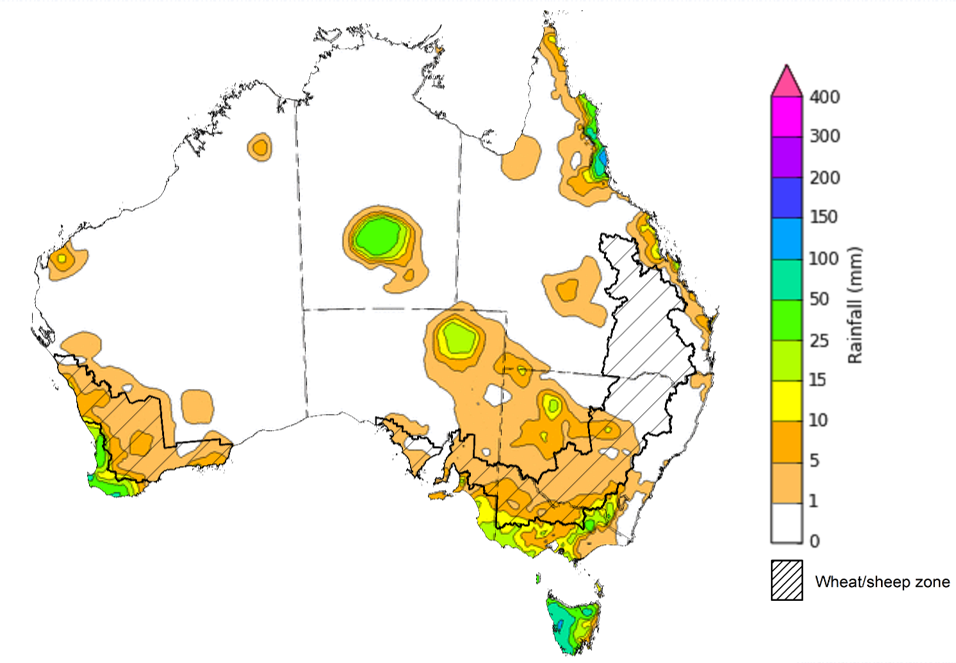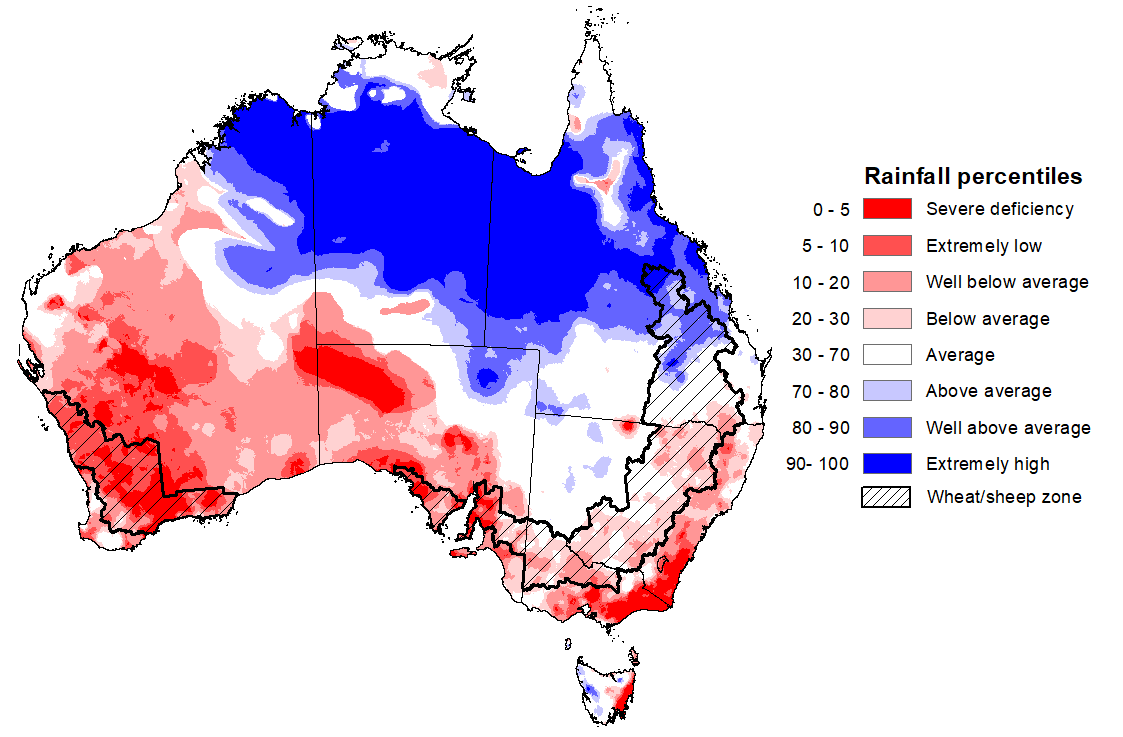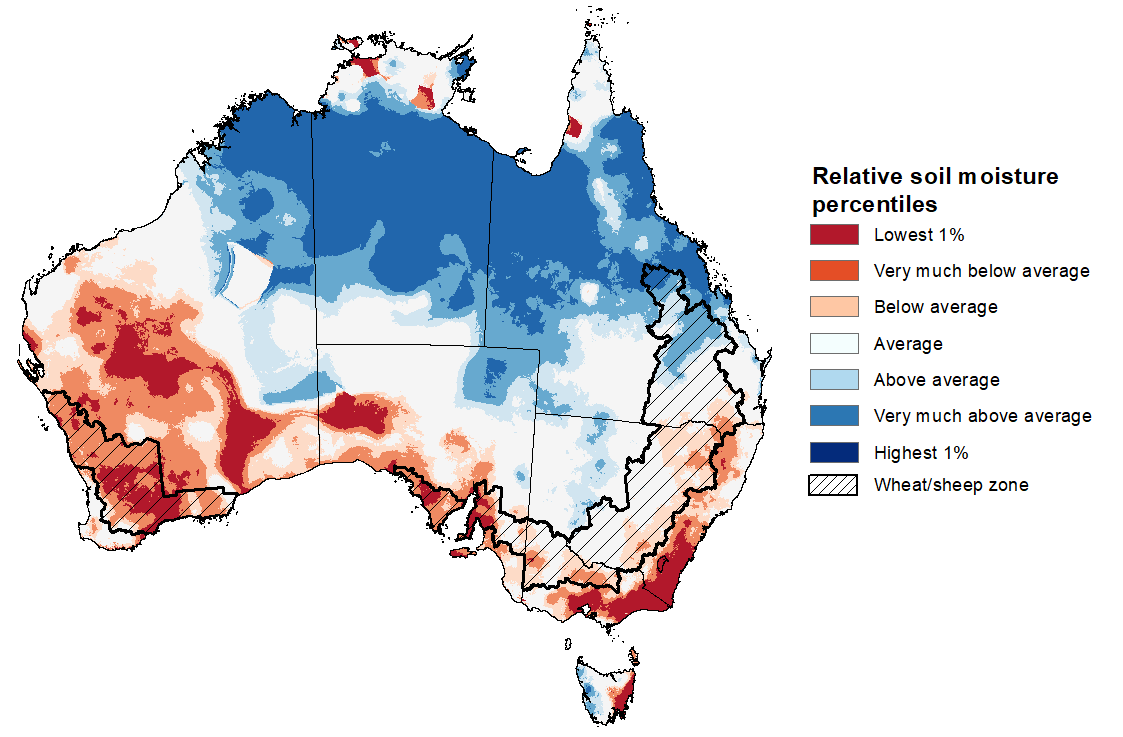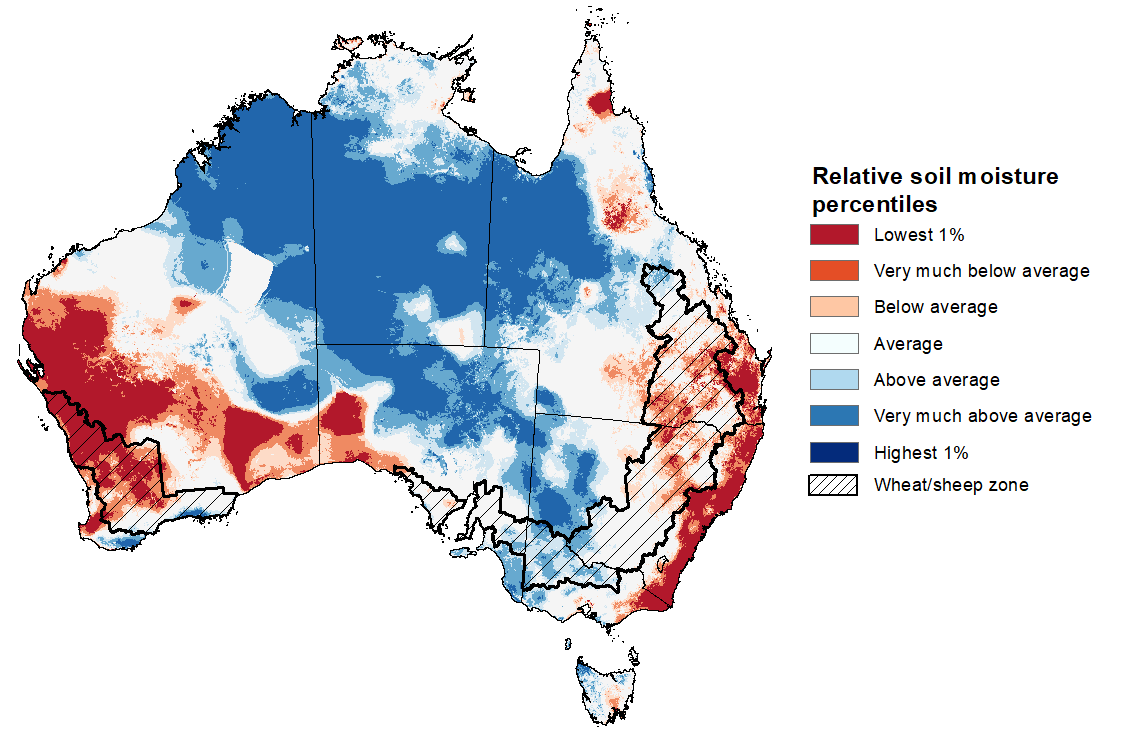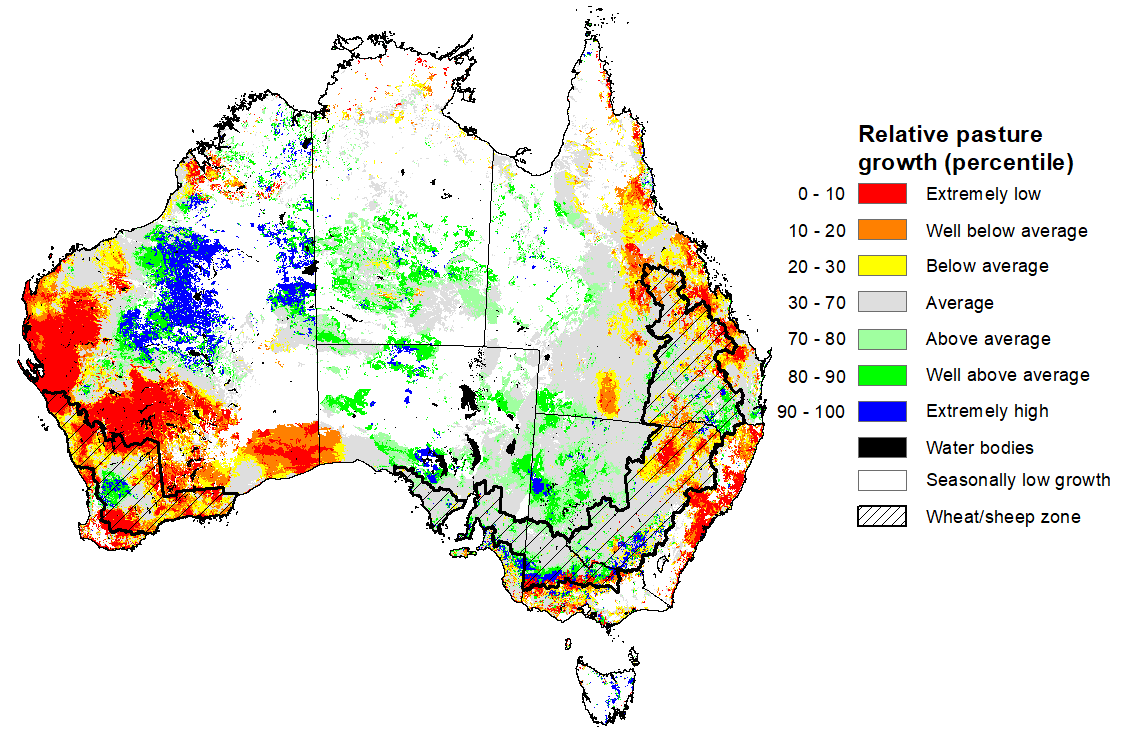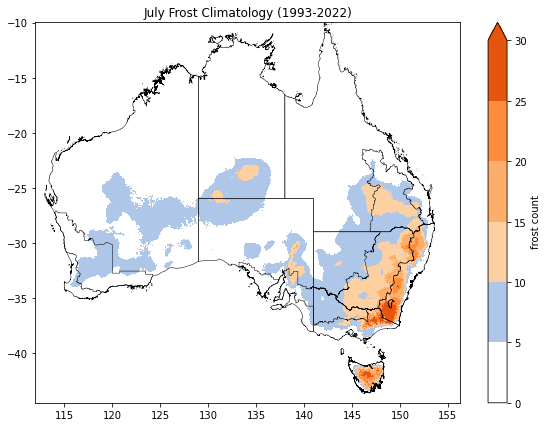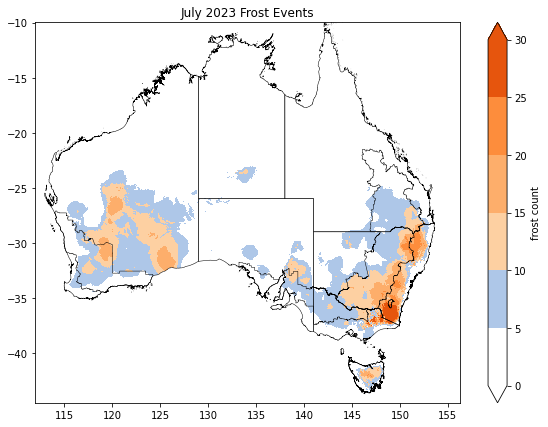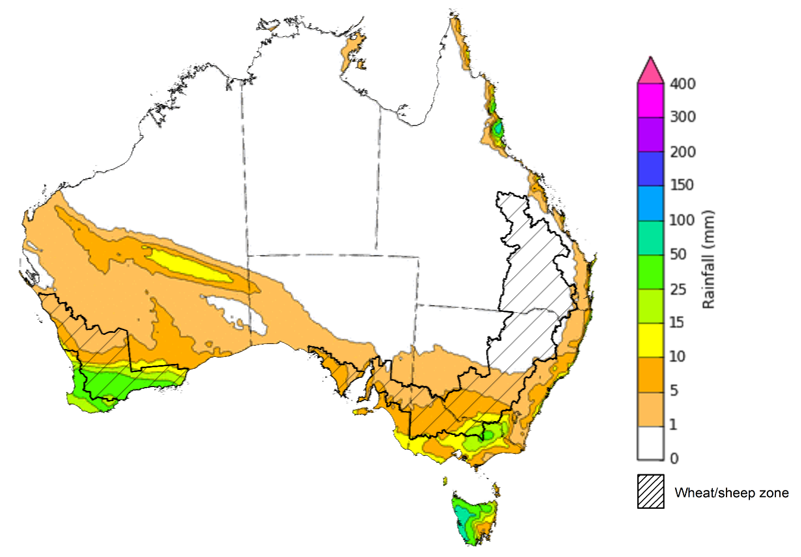Key issues
- For the week ending 2 August 2023, a series of cold fronts brought isolated falls to parts of western, southern and south-eastern Australia. Scattered falls were also recorded across parts of northern Queensland, and the interior of Northern Territory.
- Across cropping regions, rainfall totals of up to 10 millimetres were recorded in central and southern New South Wales and across Victoria, parts of South Australia and Western Australia. This has likely only been enough to sustain crop and pasture growth but insufficient to build up soil moisture reserves. Little to no rainfall was recorded in Queensland and northern New South Wales (see Section 1.1).
- Rainfall during July 2023 was slightly above the long-term average at a national level. An unseasonal rainfall event brought above average to extremely high rainfall to northern Australia. In cropping regions, July rainfall was extremely low in Western Australia and large areas of South Australia. Rainfall was below average across much of Victoria and large areas of New South Wales. Below average rainfall has seen little improvement in soil moisture levels in northern New South Wales, and central and northern Western Australia. These areas will require timely rainfall in the coming weeks to sustain crop growth at current levels (see Section 1.2).
- For the 3 months to July 2023, above average rainfall totals resulted in above average to extremely high pasture production for this time of year across much of central Western Australia, and parts of southern Northern Territory, South Australia, western and southern New South Wales, parts of western and south-eastern Queensland, and central Victoria. Average to extremely high pasture production across grazing regions will likely enable farmers to continue to maintain current stock numbers and provide opportunities to build standing dry matter availability. Below average pasture growth over the past 3 months will likely result in graziers not being able to maintain current stocking rates leading to increased turnoff across parts of tropical northern Australia. Across southern Australia, graziers will be more reliant on supplementary feed to maintain stocking rates and production (see Section 1.4).
- Over the 8 days to 10 August 2023, a low-pressure system is expected to bring showers to southern parts of the country early in the week. Onshore winds are expected to bring showers to coastal Queensland. A high-pressure system is expected to bring mainly dry conditions to the remainder of the country (see Section 1.6).
- Across cropping regions, rainfall totals of up to 50 millimetres are expected across southern Western Australia, while falls of between 5 and 25 millimetres are expected in Victoria and up to 15 millimetres in southern parts of New South Wales. South Australia is expected to receive lighter falls of up to 10 millimetres. If these falls eventuate as forecast, they are likely to be sufficient to support ongoing crop and pasture growth and development. Little to no rainfall is forecast for cropping regions in central and southern Queensland, northern New South Wales and northern Western Australia. Crops is these areas will be particularly prone to heat and moisture stress over spring (see Section 1.6).
- Water storage levels in the Murray-Darling Basin (MDB) increased between 27 July 2023 and 3 August 2023 by 3672 gigalitres (GL). Current volume of water held in storage is 20 704 GL. This is 1 percent or 139 GL less than at the same time last year.
- Allocation prices in the Victorian Murray below the Barmah Choke increased from $118 on 27 July 2023 to $126 on 3 August 2023. Prices are lower in the Goulburn-Broken and regions above the Barmah choke due to the binding of the Goulburn intervalley trade limit and Barmah choke trade constraint.
Climate
For the week ending 2 August 2023, a series of cold fronts moved across parts of western, southern and south-eastern Australia. Weekly rainfall totals of 10 to 50 millimetres were recorded in central and south-eastern New South Wales, north-east and southern Victoria and parts of South Australia, northern Queensland, south-west Western Australia, the interior of Northern Territory and most of Tasmania. Rainfall in excess of 100 millimetres were recorded in western Tasmania and coastal tropical Queensland. A high-pressure system kept the remainder of the country dry and clear.
Across cropping regions, rainfall totals of up to 10 millimetres were recorded in central and southern New South Wales and across Victoria, South Australia and Western Australia. This has likely only been enough to sustain crop and pasture growth but insufficient to build up soil moisture reserves. Little to no rainfall was recorded in Queensland and northern New South Wales and these regions will require sufficient and timely rain in the coming weeks and months to maintain current levels of winter crop production, following a gradual decline in soil moisture reserves.
Rainfall for the week ending 2 August 2023
Note: The rainfall analyses and associated maps utilise data contained in the Bureau of Meteorology climate database, the Australian Data Archive for Meteorology (ADAM). The analyses are initially produced automatically from real-time data with limited quality control. They are intended to provide a general overview of rainfall across Australia as quickly as possible after the observations are received. For further information go to http://www.bom.gov.au/climate/rainfall/
Rainfall during July 2023 was highly variable but slightly above the long-term average at a national level. An unseasonal rainfall event early in the month, brought above average to extremely high to northern parts of Western Australia, much of Northern Territory and Queensland, and isolated parts in northern South Australia and western Tasmania. Rainfall was below average to extremely low in lower two thirds of Western Australia, most of South Australia, Victoria and eastern New South Wales and Tasmania.
In cropping regions, July rainfall was extremely low in Western Australia and large areas of South Australia. Rainfall was below average across much of Victoria and large areas of New South Wales. Average rainfall was recorded in Southern Queensland and central New South Wales. Below average rainfall has seen little improvement in soil moisture levels in northern New South Wales, and central and northern Western Australia. These areas will require timely rainfall in the coming weeks to sustain crop growth at current levels. Above average to extremely high rainfall was recorded in northern Queensland cropping regions.
Rainfall percentiles for July 2023
Upper layer soil moisture in July 2023 follows a very similar pattern to July rainfall. It was above average to extremely high for most of northern Australia. It was extremely low to below average for much of western and southern Western Australia, southern South Australia, south-eastern Queensland, eastern New South Wales and most of Victoria. July upper layer relative soil moisture levels were generally average in the remaining areas.
At this time of year, upper layer soil moisture is important for the germination and establishment of winter crops and pastures across eastern and southern Australia.
In cropping regions, upper layer soil moisture was generally below average. However, it was average across western margins of New South Wales and parts of central Victoria and above average across northern Queensland. Average levels to above average of soil moisture would have supported winter crops through germination and establishment for later sown crops.
Modelled upper layer soil moisture for July 2023
Relative lower layer soil moisture for July 2023 was highly variable across Australia. It was above average across most of northern and central Australia, extending diagonally in a south-eastward direction through northern South Australia, western New South Wales and western Victoria. Parts of southern Western Australia and western Tasmania also had above average lower-level soil moisture. Relative lower layer soil moisture was very much below average for much of eastern Queensland, northern and coastal New South Wales, western and south-eastern Western Australia, southwest South Australia, and in scattered areas in eastern Victoria and Tasmania. Relative lower layer soil moisture was average elsewhere.
Lower layer soil moisture is a larger, deeper store that is slower to respond to seasonal conditions and tends to reflect the accumulated effects of events that have occurred over longer periods. Crop development and pasture growth in areas of above average lower layer soil moisture are typically less reliant on timely and frequent in-season rainfall events than in areas with below average lower layer soil moisture.
In cropping regions, lower layer soil moisture was extremely low to below average across much of Queensland, northern New South Wales and northern and central Western Australia. Areas with below average levels of lower layer soil moisture will be highly dependent on timely and sufficient in-season rainfall to support current levels of winter crop production.
Modelled lower layer soil moisture for July 2023
As northern Australia enters the dry season, pasture growth declines significantly due to the reduction in water availability, with livestock relying on pasture grown throughout the previous wet season. As south-eastern Australia enters winter, pasture growth typically increases, reflecting higher rainfall totals, and reduced temperatures and evapotranspiration rates at this time of year. Pasture availability during this period influences the growth and branding and marking rates of lambs and calves, livestock turnoff and the production of meat, milk, and wool.
For the 3 months to July 2023, above average rainfall totals resulted in above average to extremely high pasture production for this time of year across much of central Western Australia, and parts of southern Northern Territory, South Australia, western and southern New South Wales, parts of western and south-eastern Queensland, and central Victoria. Average to extremely high pasture production across grazing regions will likely enable farmers to continue to maintain current stock numbers and provide opportunities to build standing dry matter availability.
In contrast, extremely low to below average pasture growth rates were recorded across much of eastern Queensland, northern and coastal New South Wales, western and southern Western Australia and southern Victoria. Across parts of tropical northern Australia, below average pasture growth over the past 3 months will likely result in graziers not being able to maintain current stocking rates leading to increased turnoff. Across southern Australia, graziers will be more reliant on supplementary feed to maintain stocking rates and production.
Relative pasture growth for 3-months ending July 2023 (1 May 2023 to 30 July 2023)
Source: Queensland Department of Science, Information Technology, and Innovation.
Frost occurs on clear nights during winter and early spring when the air temperature drops to 2°C or less and is most pronounced in the southern and eastern agricultural regions. The weather events that typically generate damaging frosts is from the passage of cold fronts, followed by cold southerly winds and a high-pressure ridge. The severity and extent of subsequent damage is variable across the landscape. Crop damage from frost may occur at any stage of development but is most damaging around flowering and grain filling in spring. In July, crops are in early stages of emergence and stem elongation and are less susceptible to permanent frost damage.
However severe frosts (minimum temperatures below -2°C) can cause freezing damage to crop when there is rapid ice crystal formation form within the tissue. The ice crystals physically rupture cell walls and membranes within the cells causing physical damage. Damage can be seen once thawed as dark green water-soaked areas. Ten days after a frost event bleached leaves, stems and reproductive tissue might be evident depending on the growth stage of the crop.
Cold temperatures, when combined with wet and windy conditions can also have severe impacts on lambs and recently shorn animals. It can cause hypothermia when too much heat is lost, or too little body heat is produced. If the cool period is prolonged, a lamb’s capacity to maintain a stable body temperature may be exceeded, resulting in cold stress.
Based on the 30-year (1993-2022) climatology for July, much of the southern Australia records less than 10 days of frosty conditions. In eastern Australia, up to 20 days of frost events can be seen in the central and northern New South Wales, up to 15 days in southern Queensland and in scattered areas of eastern South Australia and Northern Territory. Over 25 days of frost events can be expected in southern New South Wales and northern Victoria alpine regions and in central Tasmania. Across cropping regions, on average there are up to 15 frost events, except for along the eastern margins of New South Wales and isolated parts of southern and western Queensland where it can experience up to 20 frost events.
In cropping regions in July 2023, fewer than average potential frost events were recorded in Queensland and northwest New South Wales while twice as many were recorded in Western Australia.
Number of days with minimum temperature below 2°C in July
Note: Based on standard 30-year climatology (1993-2022)
Over the 8-days to 10 August 2023, a low-pressure system is expected to bring showers to southern parts of the country early in the week. Onshore winds are expected to bring showers to coastal Queensland. A high-pressure system is expected to bring mainly dry conditions to the remainder of the country.
Across cropping regions, rainfall totals of up to 50 millimetres are expected across southern Western Australia, while falls of between 5 and 25 millimetres are expected in Victoria and up to 15 millimetres in southern parts of New South Wales. South Australia is expected to receive lighter falls of up to 10 millimetres. If these falls eventuate as forecast, they are likely to be sufficient to support ongoing crop and pasture growth and development.
However, following a dry week, little to no rainfall is forecast for cropping regions in central and southern Queensland, northern New South Wales and northern Western Australia. Crops is these areas will be particularly prone to heat and moisture stress, negatively affect crop and pasture growth given the current well below average levels of soil moisture.
Total forecast rainfall for the period 3 August 2023 to 10 August 2023
Note: This rainfall forecast is produced from computer models. As the model outputs are not altered by weather forecasters, it is important to check local forecasts and warnings issued by the Bureau of Meteorology.
Water
Water storages, water markets and water allocations - current week
The Tableau dashboard may not meet accessibility requirements. For information about the contents of these dashboards contact ABARES.
Commodities
Information on weekly price changes in agricultural commodities is now available at the Weekly commodity price update.

